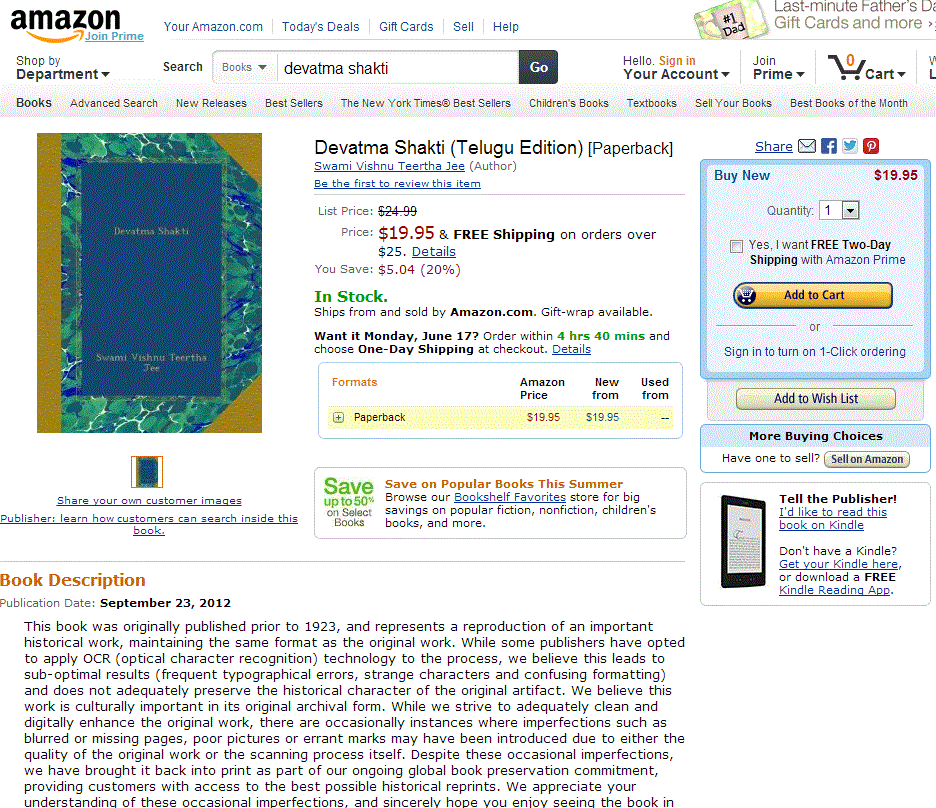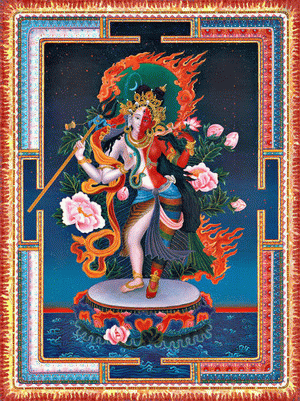Shakti (Kundalini) Divine Power. by Swami Vishnu Tirtha
Maharaj, with Forward by Mahamahopadhyaya Gopinath Kaviraj,
J.A., Formerly Principal, Government Sanksrit College,
Varanasi,1962
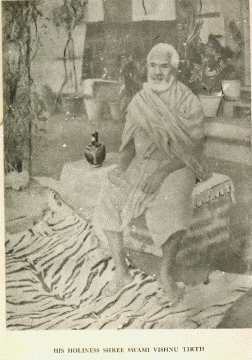
His
Holiness Shree Swami Vishnu
Tirtha

Chapter VIII
(Prana Continued)
ESCHATOLOGY
The word Prana is of the Vedic
origin, and has come to mean life on the physical plane, but
is in fact the first principle which has evolved the whole
living and the lifeless creation. Or, as has been shown, it
has involved itself during the creative process -to take up
different forms and names at different planes of creation.
Here we give below a translation of the sixth part . of the
Prashnopanishad:
“Again, verily Sukesha Bharadwaja
asked him (Pippalada) saying,
`Sire, Hiranyanabha Kaushalya of
the princely clan having come to me asked :this
question;
‘Oh, Bharadwaja ! “lost thou know
the Purusha of ‘the sixteen phases ?
‘ I told the prince,
` I know not that, had I known,
why should I not have told thee that, as with root ‘.(the’
whole family) becomes, extinct, so of one who tells a lie,
therefore I dare not speak.
the untruth.
‘ Thereupon he got into his
chariot and went away, that same question I ask thee, `what
is that Purusha ?
‘ Unto him Pippalada
replied:
‘here even in this
body, : Oh, peaceful ! is that
Purusha, of whom are produced the sixteen phases.
That Purusha thought, on whose –
leaving this, body I shall leave it and on whose ‘entering
the body shall I
enter in.
He then created Prana, From Prana
shraddhi, ether,
air, fire, water, earth, senses
“of knowledge and mind, food,
from food strength, tapas, vedas, sacrifices, lokas
(the different
planes of creation) and in the lokas names.
As the
rivers flowing seaward and
having fallen into the sea lose themselves, their names and
forms are lost, then what remains is said to be sea, so even
is in the case of this Purusha, – the seer, these sixteen
phases, reverting towards Purusha, merging into Purusha,
lose themselves and their names and forms are lost, and then
what remains is said to be Purusha and He becomes one phase
less and eternal.”
In the above dialogue it has been
shown that Prana the first principle of creation emanates
from Purusha, the Lord, and it is the Prana that gets
involved into both the physical and psychic planes. Prana is
the first cause of creation, and it is at the same time
Prana that links the psychic with the physical. – Psychic
and Physical bodies are linked together with Prima and on
Prana leaving the body the. soul too gets out along with it
on death, and on its entering a fresh body
the soul enters in it for fresh birth.
Prana as the first principle is known as the universal
mind-stuff (mahat), and is all pervading
and individually it forms. the pranamayakosha, and is known
as astral fluid to the English readers. On the physical
plane it perhaps takes the form of the nebulous matter that
ultimately transforms and takes up the form of all stars and
planets. Astral fluid that forms the outer covering of the
psychic body and the nebulous fluid are therefore
practically of the same substance on different strata.
Pranamayakosha interlinks the Annamayakosha. and the
Manomayakosha. They are so named being formed of Prana, Anna
(food) and Mind respectively and serve as sheaths of soul.
The astral fluid from upwards the physical plane rarifies
through a range of seven strata. The Indian cosmologists
have. described .the sevenfold strata of Prana separately as
pertaining to the human body, the Earth, and Brahmanda (a
cosmic unit) or the universe we see, there being innumerable
universes of the kind. Each unit consists of a family of
stars, each star being a solar centre of its respective
solar system. Each unit is known. to the Hindus as a
Brahmanda, i.e. a cosmic egg of the Creater.
In the case of mankind the seven
strata are known as chakras and are named from the bottom
upwards as mooladhar, swadhisthana, manipoor, anahat,
vishuddha, and ajna ; the seventh being sahasrar – the
thousand petalled lotus in the cerebrum. In the case of the
Earth they are ‘ called Dwipas and are named Jambu dwipa,
Shaka dwipa, Kusha dwipa, Krauncha. dwipa, Shalmali dwipa,
Plaxa dwipa, and
Pushkar dwipa. The Earth as the
physical planet known to us including the continents of
Asia, Europe, Africa and America surrounded with saline
oceans is called Jambu dwipa. The other six are astral
spheres with the higher enveloping the lower ones, i.e.,
every outer sphere envelops the next lower and is said to be
double in area. The continents that there be in them are
said to be surrounded with waters tasting respectively as
sugarcane juice, wine, clarified butter, curd; milk, boiled
rice, water, and milk.
These astral regions are invisible
to our physical vision and are transparent to the Sun-rays..
The ancients. had divided the continental land of Jambu
dwipa into seven parts, each
being called a Varsha. Their names are Ramnak, Hiranyamaya,
and Uttarkurus lying north of Nishad, Hemkut and the
Himalayas, situated from west to east, probably
corresponding to the present Europe, Central, Asia, and
China including a part of Siberia. Hari varsha, Kimpitrusha
varsha, and Bharat varsha to their, south, probably
corresponding to the present Africa, Middle East and Far
East including India respectively. They form the eastern ‘
hemisphere. Ilavrita varsha corresponds to the American
continents lying on the western hemisphere. Sumeru is the
name given to the axis, of the Earth. The above description
has been given according to Vyasa’s commentary, on Yoga
Darshan. In the third case the seven Lokas are named as
Bhurloka, Bhuwarloka, Swarlok, Maharloka, Janaloku.
Tapoloka, and Satyaloka. Earth with her seven dwipas
constitutes the Bhurloka, the sky ‘containing ‘the whole
family of stars of which the Sun is one of the members is
called Bhuwarloka and is also called Antarikshalaka. The
rest of the five are higher. astral regions enveloping the
Bhuwarloka one over the other. Satyaloka is the highest
Brahmaloka. For a more comprehensive idea readers are
referred to commentary on Patanjali’s Yoga Darshan by Vyasa
vide sutra (3.26) above referred to. All the spheres are
accessible after death to the astral bodies of spiritual
persons, who rise upto them according to the degree of
refinement of their respective astral bodies (linga
sharir).
It has been said that astral body
links the psychic body with the physic,-d body and it is the
desire of a person that acts as a motive power which governs
the astral movements. A person with a strong desire to live
and have the enjoyments of the physical. plane makes the
astral body gravitate towards the physical plane. The astral
body can be directed towards any of the astral spheres by
developing such desire and acquiring the necessary
refinement of the astral body. Such desire shall come into
effect no sooner than the astral body is detached from the
physical body after death or in life through the practice
of. yoga. Untruthfulness and, vicious desires, anger, lust
for sensual pleasures and worldly attachments for wife,
children, wealth and other secular possessions attract the –
astral body towards the physical plane. Vices, anger, and
lust, etc., disintegrate the astral body and serve as a lead
weight to keep it down. On the other hand calmness of mind,
peace, love. and virtuous deeds of philanthropy and..
magnanimity raise the astral refinement. The finest state of
refinement of the astral body is acquired through meditation
and desirelessness. When a person raises his astral fluid
(prana) through spinal (the different chakras of sushumna)
to cerebrum, the degree of refinement acquired by the astral
body at each of the chakras qualifies the person for the
corresponding a astral sphere to which he shall be entitled
to rise after death. If a person can dislink the psychic
body from the physical one, he can visit them even in life
and come back to his physical frame. Evolution of-.Prang- at
its highest degree makes it merge in the universal Prang and
then in Brahman.
If the astral body is defiled and
darkened with sinful deeds, it would descend even to lower
planes of existences such as of
evil spirits, ghosts, rakshasas, etc., and even to the
planes of animals. Mention is made of even dark regions
called hells to which persons with darkened astral bodies
are lowered. Hells are described as covered with darkness
and are earthy, watery, fiery, airy and ethereal.. Perhaps
they are the same as in
vegetable life living beings of water, they that live within
the hot wombs of the earth, animals and bird respectively:
They, are correctly said to be.groping in darkness, because
of their lacking in illumination of spirit, intellect and
even of senses of perception. On the human plane as well.
there are persons who are decidedly not higher than
animals by nature and are called human
brutes and those whose lot is, to suffer lifelong miseries
can be said to be in hell on the human plane.
Pious. persons still possessed of
desire of enjoyments are said to depart after death through
the path of the moon to swarloka and those who have become
free from all desires of secular enjoyments and of heaven
rise by the path of the sun to
the spheres of Maharloka and the higher ones according to
their stage of evolution. Those who cannot rise by either of
the paths take birth on this sphere directly.
In, the same connection it will not
be out of place here to explain the uttardyana and
dakshinayana gati referred to in Gita vide (8.26). It is
said that those who are yogis prefer to die during the
uttardyana period when the Sun moves northwards. If they die
during the other half of the year there is a likelihood of
their not rising higher. The reason is that the Sun radiates
Prana as has been said before. The universal Prana on the
northern hemisphere is on the increase or high tide as the
Sun moves northwards with the lengthening of the day time
and on the decrease or low tide during dakshinayana with the
shortening of day. Therefore when an individual prana leaves
the physical body, it receives lift with the increasing
universal Prana in his march upwards to higher regions
during uttarayana and gets setback during dakshinayana, as
his speed will be accelerated or retarded by the high or
ebb-tides of the universal Prana. Those who are not yogis,
but otherwise pious and virtuous also try to rise up but
cannot rise to – the solar region, they simply rise up to
the lunar one.
By the way it may also be explained
how the solar and lunar eclipses affect our astral bodies
for the same reason. When an eclipse occurs the natural
supply of nourishment to astral fluid is cut off and the
natural consequence follows in the shape of deterioration of
the astral fluid. In order to make up the deficiency
meditation of God and concentration of mind on one’s self,
the main sources of all prana, are prescribed. It is
therefore a custom with the Hindus to bathe in some river or
tank before an eclipse begins and sit all alone for
meditation till it is over. Joyful mind also helps the
astral body, therefore it is enjoined to give charity to the
poor and the depressed during the period of, an eclipse, as
charity makes both the benefactor, and the receiver of
charity happy and joyful.
The astral fluid, is so called,
because it shines like stars in its purest state of
refinement, but it darkens and becomes defiled through evil
deeds and vicious desires, which then becomes dull lacking
brightness – and tends to sink down to lower
planes.
The complexion of Shiva is therefore
painted as bright as the moon, and of ghosts, and evil
spirits as dark.
Let us therefore sing, with the
great poet Dr. Rabindra Nath Tagore in his beautiful song:
inner self eh,
Purify, brighten it and make it beautiful eh,
On thy lotus feet make my mind stable, eh,
Make it joyful, joyful, joyful, eh.
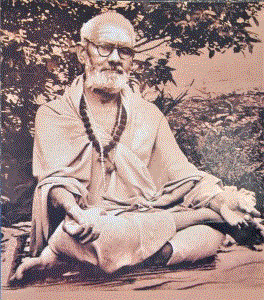
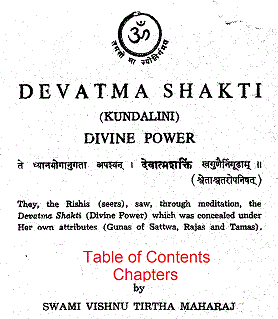

Buy Devatma Shakti on
Amazon
